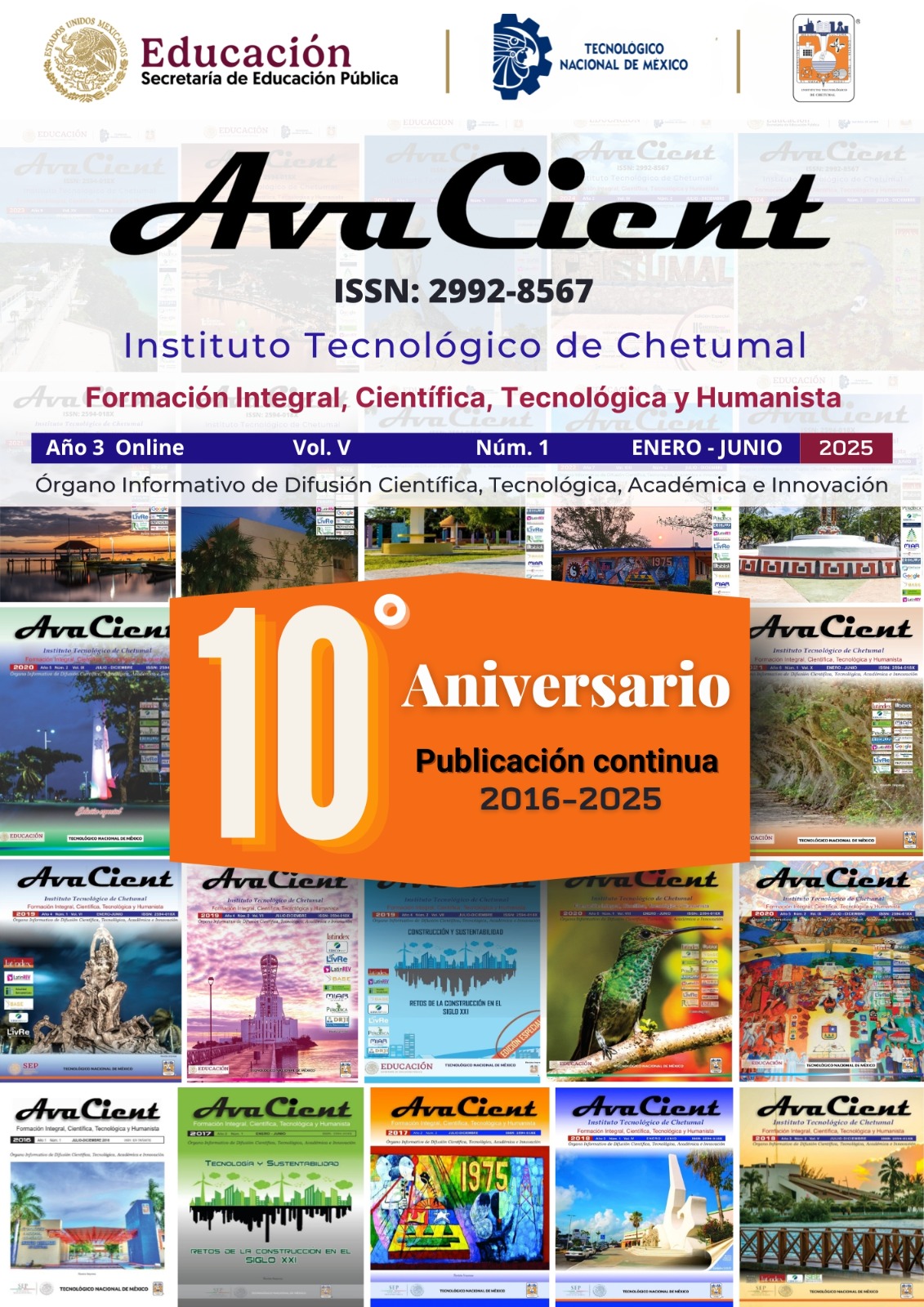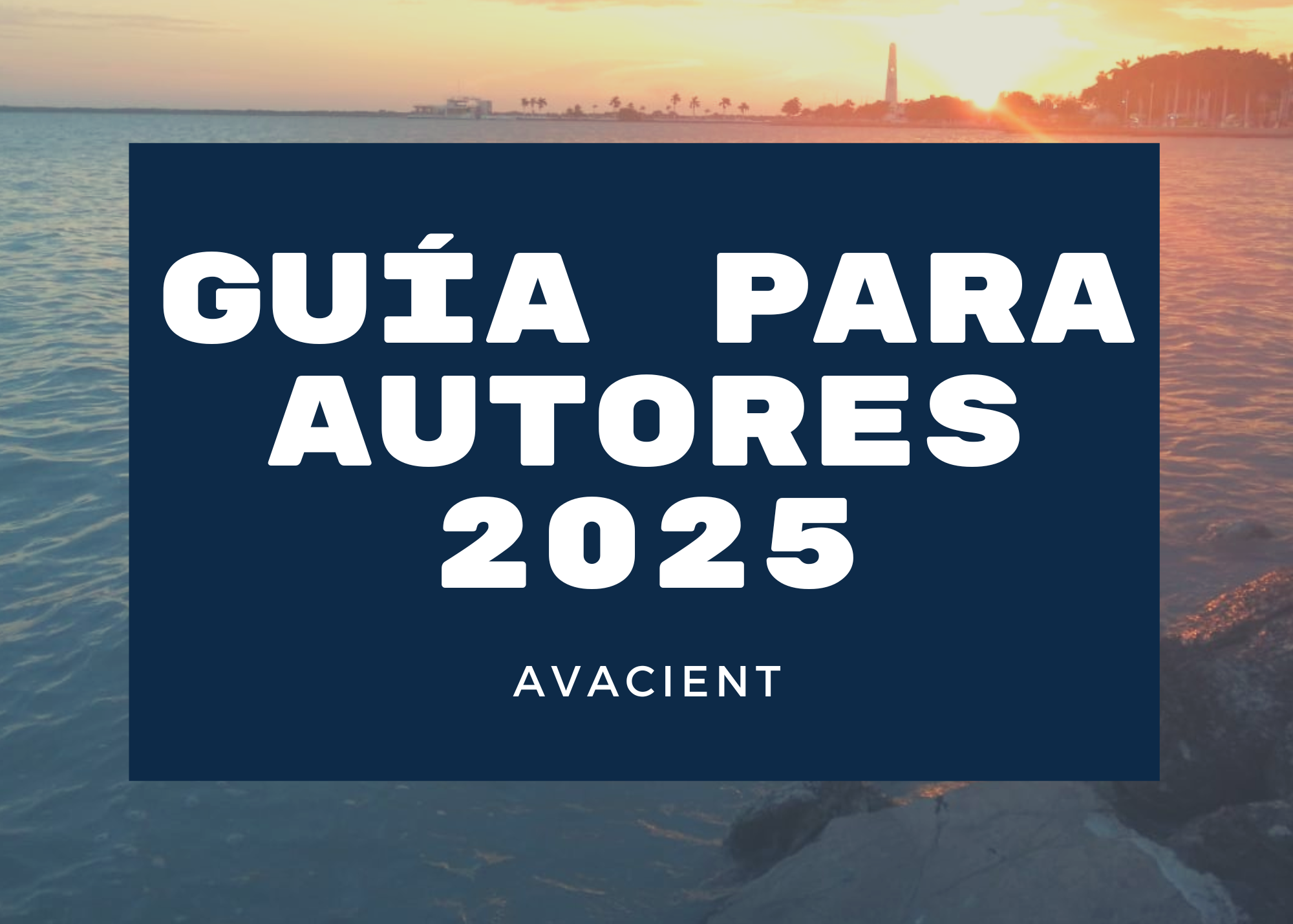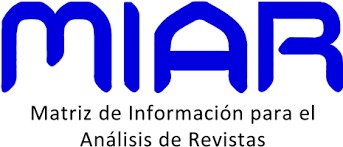USE OF SATELLITE IMAGES FOR THE CARTOGRAPHIC REPRESENTATION OF POLLUTANTS IN TULUM, QUINTANA ROO
DOI:
https://doi.org/10.69823/avacient.v5n1a4Keywords:
GHG, atmosphere, methane, ozone, coastal zoneAbstract
Due to its economic success, the city of Tulum has the highest population growth rate in Mexico, which has led to uncontrolled urban expansion. As a result of the rapid occupation of land by the development of tourist, urban and transportation infrastructure, the elimination of jungles and wetlands is observed in the area and an increase in the demand for services for inhabitants and tourists, which is reflected in a greater consumption of fossil fuels, and in turn a greater release of greenhouse gases (GHG). In this context, the objective of this work is to make evident the levels of atmospheric pollutants methane (CH4), ozone (O3) and formaldehyde (CH2O) between 2018-2023 in the municipality of Tulum through the geo-processing of satellite images with the Google Earth tool and the SNAP, ArcMap and QGIS programs. The pollutant observed in greatest quantity is methane, followed by ozone and finally formaldehyde. In this regard, it is important to consider that compounds such as methane, and other hydrocarbons react with hydroxyl radicals (-OH) generated by the high solar radiation characteristic of the area. These reactions lead to the formation of intermediate compounds such as formaldehyde.
Downloads
References
Air Alliance Houston [AAH]. (2024, 15 noviembre). Contaminación atmosférica 101. https://airalliancehouston.org/es/contaminacion-atmosferica-101/#:~:text=¿Qué%20es%20la%20Contaminación%20Atmosférica,reacciones%20secundarias%20de%20ciertos%20hidrocarburos.
Agencia para Sustancias Tóxicas y el Registro de Enfermedades, Gobierno de EUA [ATSDR]. (2016, 6 mayo). Resúmenes de salud pública – Formaldehído. https://www.atsdr.cdc.gov/es/phs/es_phs111.html
Atkinson, R. (2000). Atmospheric chemistry of VOCs and NOx. Atmospheric Environment, 34(12), 2063-2101. https://doi.org/10.1016/S1352-2310(99)00460-4
Brankovits, D., Pohlman, J.W., Niemann, H. Leigh, M.B, Leewis, MC, Becker, K.W., Iliffe, T.M., Alvarez, F., Lehmann, M.F., Phillips, B. (2017). Methane and dissolved organic carbon-fueled microbial loop supports a tropical subterranean estuary ecosystem. Nature Communications 8 (2017). https://doi.org/10.1038/s41467-017-01776-x
Comisión Económica para América Latina y el Caribe [CEPAL]. (2018, 24 septiembre). Efectos del cambio climático en la costa de América Latina y el Caribe: Metodologías y herramientas para la evaluación de impactos de la inundación y la erosión. https://hdl.handle.net/11362/44096.
Estrada-Porrúa, F., Zavala-Hidalgo, J., Martínez-Arroyo, A., Raga, G. y Gay-García, G. (eds) (2023, 1 octubre). Estado y Perspectivas del Cambio Climático en México: Un Punto de Partida. https://www.caacs.unam.mx/wp-content/files/estado-y-perspectivas-del-cambio-climatico-en-mexico-un-punto-de-partida-unam.pdf
Filippi, F. (2016). Cambio climático y desarrollo. Implicaciones del cambio climático en la cooperación para el desarrollo (3ª ed.). Consultado el 22 de noviembre de 2024. https://musol.org/wp-content/uploads/2024/11/Manual-Cambio-Climatico-Implicaciones-del-Cambio-Climatico-en-la-Cooperacion-para-el-Desarrollo.pdf
Gurjar, B. R., Molina, L. T., y Ojha, C. S. P. (eds) (2010). Air pollution: Health and environmental impacts (1ª ed.). CRC Press. ISBN 9781439809624.
Jacob, D. J. (1999). Introduction to Atmospheric Chemistry (1ª ed.). Princeton University Press. ISBN 9780691001852
Instituto Nacional de Ecología y Cambio Climático [INECC]. (2021). Gases y compuestos de efecto invernadero. Consultado el 22 de noviembre de 2024. https://cambioclimatico.gob.mx/estadosymunicipios/Emisiones.html
International Council on Clean Transportation [ICCT]. (2017, 17 octubre). Greenhouse gas emissions from global shipping: 2013-2015. https://theicct.org/wp-content/uploads/2021/06/Global-shipping-GHG-emissions-2013-2015_ICCT-Report_17102017_vF.pdf.
Instituto Nacional de Estadística y Geografía [INEGI]. (2020). Censo de Población y Vivienda 2020. Consultado el 15 de noviembre de 2024. https://www.inegi.org.mx/programas/ccpv/2020/
Intergovernmental Panel on Climate Change [IPCC]. (2014). Climate change 2013: The physical science basis. Cambridge University Press. Online ISBN 9781107415324. https://doi.org/10.1017/CBO9781107415324
Maldonado, J. H. y Moreno-Sánchez, R. del P. (2023, 15 junio). Servicios ecosistémicos y biodiversidad en América Latina y el Caribe. Políticas para la respuesta al cambio climático y la preservación de la biodiversidad. CAF-Banco de Desarrollo de América Latina y el Caribe. https://scioteca.caf.com/handle/123456789/2051
Magrin, G. O. (2015, 1 diciembre). Adaptación al cambio climático en América Latina y el Caribe. Naciones Unidas Comisión Económica para América Latina y el Caribe (CEPAL). https://repositorio.cepal.org/server/api/core/bitstreams/618b144d-e069-4e38-8e12-1da1a0bdb817/content
México ante el Cambio Climático [MCC] (2021). Inventario Nacional de Emisiones de Gases y Compuestos. Consultado el 22 de noviembre de 2024. https://cambioclimatico.gob.mx/inventario-nacional-de-emisiones-de-gases-y-compuestos/
Minnesota Department of Health [MDH]. (2024). Metano en el agua de pozo [Methane in well water]. Consultado el 15 de noviembre de 2024. https://www-health-state-mn-us.translate.goog/communities/environment/water/wells/waterquality/methane.html?_x_tr_sl=en&_x_tr_tl=es&_x_tr_hl=es&_x_tr_pto=rq
Ministerio de Trabajo Empleo y Seguridad Social Argentina [MTESSA]. (2021, 21 julio). Formaldehído. https://www.argentina.gob.ar/sites/default/files/guia_formaldehido_julio_2021.pdf
Moreno-Díaz, M. L. (2020). Impacto socioeconómico de la variabilidad climática en pesca y turismo: antecedentes y propuesta metodológica. Revista de Biología Tropical, 68, 18-32. https://dx.doi.org/10.15517/rbt.v68is1.41127
Municipio de Tulum. (2023, 9 julio). Atlas de Riesgo del Municipio de Tulum. https://tulum.gob.mx/inciso-p/
Municipio de Tulum. (2024). Propuesta de Plan de Acción Climática. Consultado el 22 de noviembre de 2024. https://tulum.gob.mx/wp-content/uploads/2024/01/PAC-Tulum-Propuesta-Final.pdf
Murray, G. N., Perea, K., Mendoza, A., Jaramillo, V. J., Murguía-Flores, F., Martínez, A., García, G. M. A., Vargas, R. (2023). Flujos de gases y compuestos de efecto invernadero en México en décadas recientes (2000-2019). Consultado el 29 de noviembre. https://cambioclimatico.unam.mx/wp-content/uploads/2023/10/cambio-climatico-en-mexico-emisiones-flujos-gycei.pdf
National Toxicology Program [NTP] (2010, 22 enero). Final report on carcinogens background document for formaldehyde. https://www.researchgate.net/publication/273439236_Final_Report_on_Carcinogens_Background_Document_for_Formaldehyde
Organization Mundial de la Salud [OMS]. (2022, 21 junio). Radiación ultravioleta. https://www.who.int/es/news-room/fact-sheets/detail/ultraviolet-radiation
OMS (2024, 24 octubre) Organización Mundial de la Salud. Ambient (outdoor) air pollution. https://www.who.int/news-room/fact-sheets/detail/ambient-(outdoor)-air-quality-and-health
Organization Mundial de la Salud [OMS] (2016, 13 mayo). Ambient air pollution: A global assessment of exposure and burden of disease. https://www.who.int/publications/i/item/9789241511353
Organización No Gubernamental Manos Unidas [ONGMU]. (2024). Principales contaminantes atmosféricos. Consultado el 29 de noviembre de 2024. https://www.manosunidas.org/sites/default/files/principales_contaminantes_atmosfericos.pdf.
Programa de las Naciones Unidas para el Medio Ambiente [PNUMA] y Climate Clean Air Coalition [CCAC] (2017). Avances y oportunidades en la reducción de contaminantes climáticos de vida corta en América Latina y el Caribe. https://www.ccacoalition.org/sites/default/files/resources/LAC%20SLCP%20Technical%20Report%20ESPANOL%202019%202%20web.pdf.
Reddy, K. R. y DeLaune, R. D. (2008). Biogeochemistry of wetlands: Science and applications (1ª ed.). CRC Press. ISBN 9780429095764. https://doi.org/10.1201/9780203491454
Secretaria de Turismo [SECTUR] (2020, 1 diciembre). Pueblos Mágicos de México. https://www.gob.mx/sectur/articulos/pueblos-magicos-206528.
Seinfeld, J. H. y Pandis, S. N. (2016). Atmospheric chemistry and physics: From air pollution to climate change (3ª ed.). Wiley. ISBN 978-1-118-94740-1.
Sistema Nacional de Información de la Calidad del Aire [SINAICA]. (2024). Normas Oficiales Mexicanas en materia de salud ambiental. Consultado el 22 de noviembre de 2024. https://sinaica.inecc.gob.mx/pags/noms.php
United Nations [UN]. (s. f.). Datos básicos sobre la acción climática. Consultado el 29 de noviembre de 2024. https://www.un.org/es/climatechange/science/key-findings#physical-science
United Nation Environment Program [UNEP]. (2021, 20 agosto). Las emisiones de metano están acelerando el cambio climático. ¿Cómo Podemos reducirlas? https://www.unep.org/es/noticias-y-reportajes/reportajes/las-emisiones-de-metano-estan-acelerando-el-cambio-climatico-como
World Health Organization Ambient (outdoor) air pollution [PNUMA]. (2020). https://www.who.int.
Zhang, H., Xu, Y. Jia, L. (2023). Evaluation of ozone formation potential of formaldehyde using smog chamber data. Aerosol and Air Quality Research 23 (5). https://doi.org/10.4209/aaqr.220323
Downloads
Published
How to Cite
Issue
Section
License
Copyright (c) 2025 AvaCient

This work is licensed under a Creative Commons Attribution-NonCommercial 4.0 International License.












